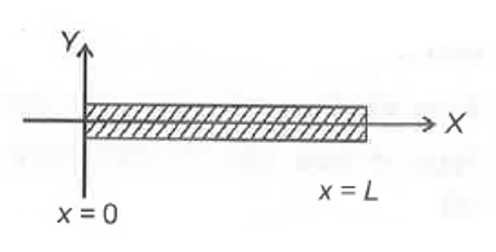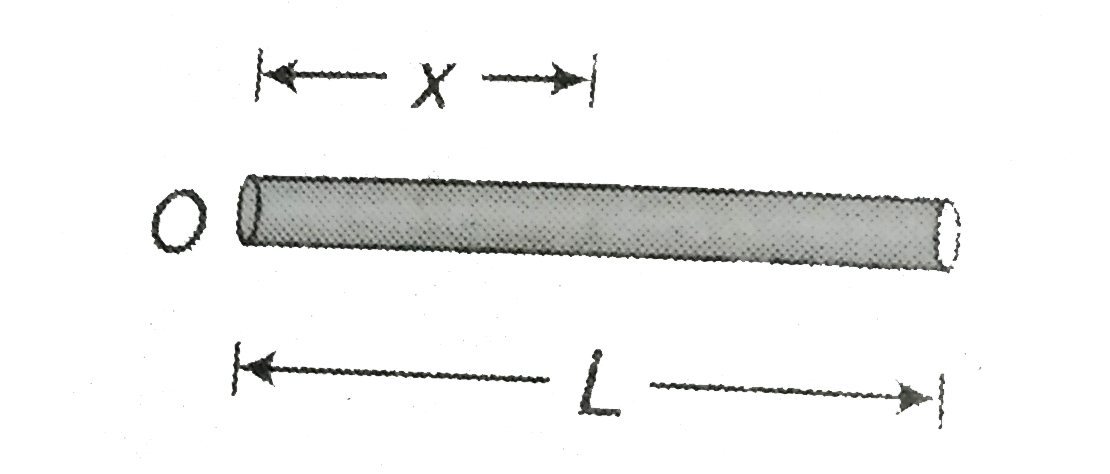If the linear density (mass per unit length) of a rod of length 3m is proportional to x, where x, where x is the distance from one end of the rod, the distance of the centre of gravity of the rod from this end is.
2.5 m
1 m
1.5 m
2 m
The correct Answer is:D
To find the distance of the center of gravity of a rod of length 3 m, where the linear density is proportional to the distance from one end, we can follow these steps:
Step 1: Define the linear density
We know that the linear density λ (mass per unit length) is proportional to the distance x from one end of the rod. We can express this as:
λ=kx
where k is a constant of proportionality.
Step 2: Determine the mass of an infinitesimal element
Consider an infinitesimal element of the rod of length dx at a distance x from the end. The mass dm of this element can be expressed as:
dm=λ⋅dx=kx⋅dx
Step 3: Set up the integrals for the center of mass
The center of mass xcm of the rod can be calculated using the formula:
xcm=∫L0xdm∫L0dm
where L is the length of the rod (3 m in this case).
Step 4: Calculate the numerator
Substituting dm into the integral for the numerator:
∫L0xdm=∫L0x⋅(kxdx)=k∫L0x2dx
Calculating the integral:
∫L0x2dx=(x33)L0=L33
Thus, the numerator becomes:
k⋅L33
Step 5: Calculate the denominator
Now, we calculate the denominator:
∫L0dm=∫L0kxdx=k∫L0xdx
Calculating this integral:
∫L0xdx=(x22)L0=L22
Thus, the denominator becomes:
k⋅L22
Step 6: Substitute into the center of mass formula
Now we can substitute the results from steps 4 and 5 into the center of mass formula:
xcm=k⋅L33k⋅L22=L33L22=2L3
Step 7: Calculate the distance from the end
Substituting L=3m:
xcm=2⋅33=2m
Thus, the distance of the center of gravity from one end of the rod is 2 meters.
Final Answer
The distance of the center of gravity of the rod from the end is 2 meters.
---
We know that the linear density λ (mass per unit length) is proportional to the distance x from one end of the rod. We can express this as:
λ=kx
where k is a constant of proportionality.
Consider an infinitesimal element of the rod of length dx at a distance x from the end. The mass dm of this element can be expressed as:
dm=λ⋅dx=kx⋅dx
The center of mass xcm of the rod can be calculated using the formula:
xcm=∫L0xdm∫L0dm
where L is the length of the rod (3 m in this case).
Substituting dm into the integral for the numerator:
∫L0xdm=∫L0x⋅(kxdx)=k∫L0x2dx
Calculating the integral:
∫L0x2dx=(x33)L0=L33
Thus, the numerator becomes:
k⋅L33
Now, we calculate the denominator:
∫L0dm=∫L0kxdx=k∫L0xdx
Calculating this integral:
∫L0xdx=(x22)L0=L22
Thus, the denominator becomes:
k⋅L22
Now we can substitute the results from steps 4 and 5 into the center of mass formula:
xcm=k⋅L33k⋅L22=L33L22=2L3
Substituting L=3m:
xcm=2⋅33=2m
The distance of the center of gravity of the rod from the end is 2 meters.
Topper's Solved these Questions
- BOOK - A2ZCHAPTER - ROTATIONAL DYNAMICSEXERCISE - AIIMS Questions40videos
ROTATIONAL DYNAMICS
- BOOK - A2ZCHAPTER - ROTATIONAL DYNAMICSEXERCISE - Chapter Test29videos
ROTATIONAL DYNAMICS
- BOOK - A2ZCHAPTER - ROTATIONAL DYNAMICSEXERCISE - Assertion Reasoning20videos
ROTATIONAL DYNAMICS
- BOOK - A2ZCHAPTER - PROPERTIES OF MATTEREXERCISE - Chapter Test29videos
PROPERTIES OF MATTER
- BOOK - A2ZCHAPTER - THERMAL PROPERTIES OF MATTEREXERCISE - Chapter Test30videos
THERMAL PROPERTIES OF MATTER
Similar Questions
The linear density of a thin rod of length 1m lies as λ=(1+2x), where x is the distance from its one end. Find the distance of its center of mass from this end.
View SolutionThe mass per unit length of a non- uniform rod OP of length L varies as m=k(x)/(L) where k is a constant and x is the distance of any point on the rod from end 0 .The distance of the centre of mass of the rod from end 0 is
View Solution
Knowledge Check
- Question 1 - Select One
The mass per unit length of a non - uniform rod of length L is given μ=λx2 , where λ is a constant and x is distance from one end of the rod. The distance of the center of mas of rod from this end is
AL2BL4C3L4DL3 - Question 2 - Select One
The mass per unit length of a non-uniform rod of length L is given by μ=λ×2, where λ is a constant and x is distance from one end of the rod. The distance of the center of mass of rod from this end is :-
AL2BL4C3L4DL3 - Question 3 - Select One
A rod of length 3m and its mass par unit length is directly proportional to the distance x from its one end . The centre of gravity of the rod from that end will be at :-
A1.5 mB2 mC2.5mD3.0 m
The centre of mass of a non-uniform rod of length L whose mass per unit length λ is proportional to x2, where x is distance from one end
 View Solution
View SolutionThe linear mass density i.e. mass per unit length of a rod of length L is given by ρ=ρ0(1+xL), where ρ0 is constant , x distance from the left end. Find the total mass of rod and locate c.m. from the left end.
 View Solution
View SolutionThe density of a linear rod of length L varies as ρ=A+Bx where x is the distance from the left end. Locate the centre of mass.
 View Solution
View SolutionThe linear mass density (i.e. Mass per unit length) of a rod of length L is given by ρ=ρ0xL, where ρ0 is constant and x is the distance from one end A. Find the M.I. about an axis passing through A and perpendicular to length of rod. Express your answer in terms of mass of rod M and length L.
View SolutionA rod of length 3 m has its mass per unit length directly proportional to distance x from one of its ends then its centre of gravity from that end will be at
View Solution

